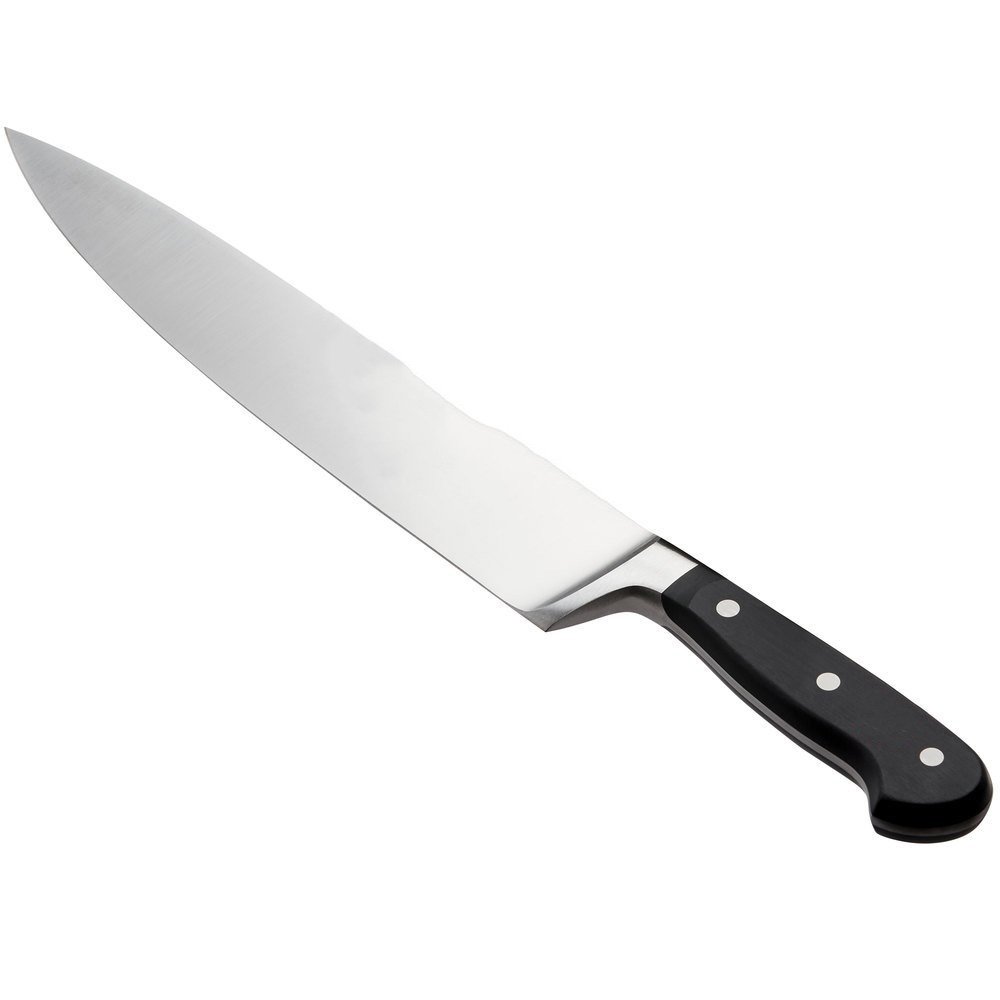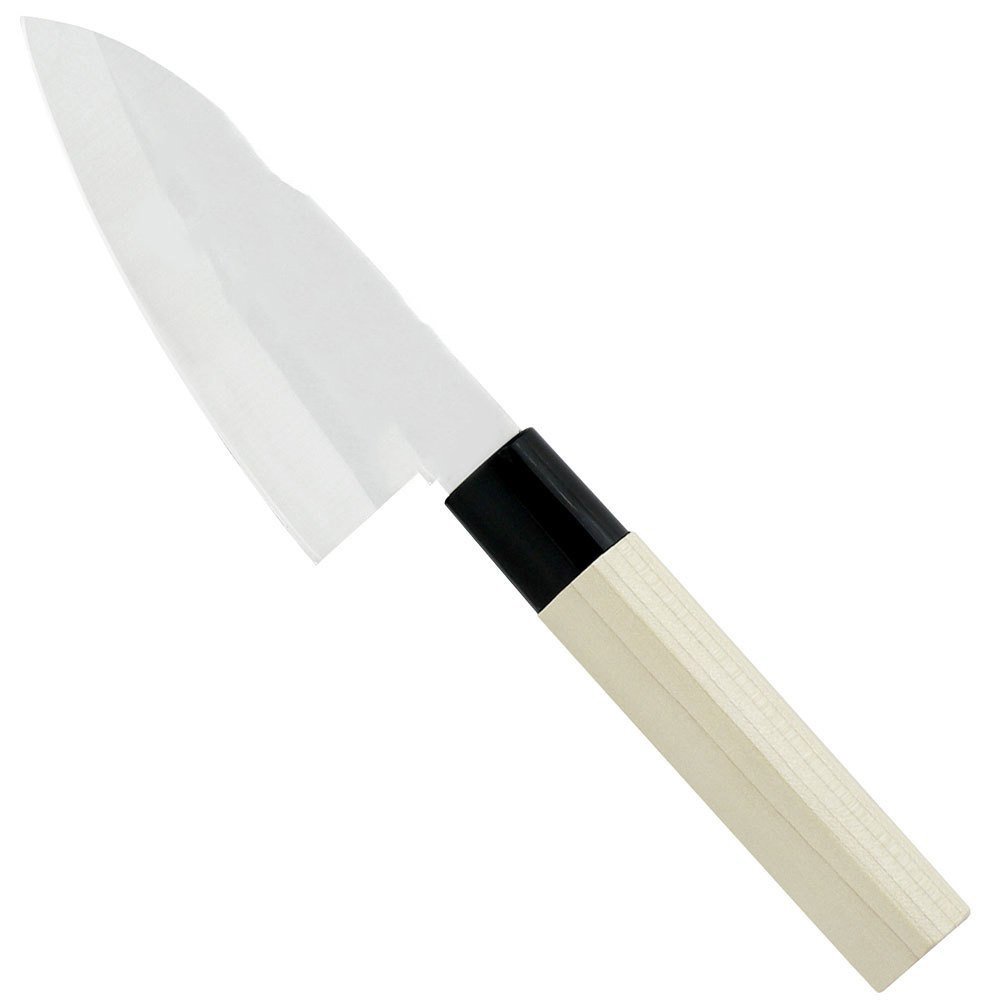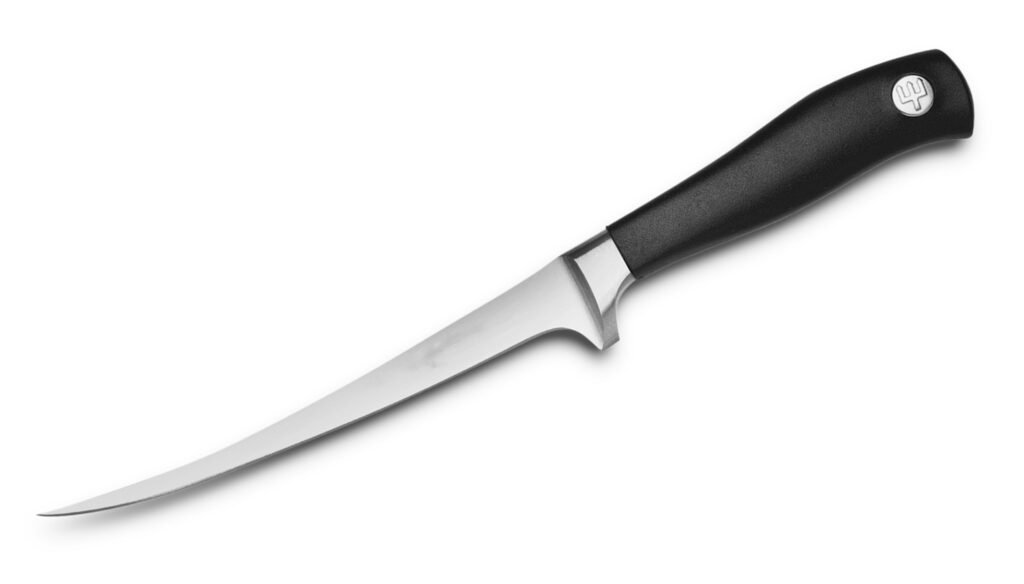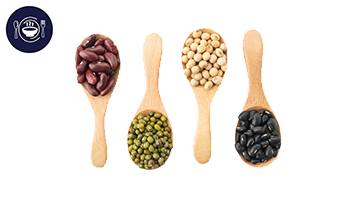Without this tool in our kitchen our cooking is incomplete, without this tool we cant garnish the cooked food too. this tool’s name is KNIFE.
Knives are the most important tool in a kitchen, and they can be used for just about any food prep task from chopping onions to opening oysters and slicing bread. But, there are different types of kitchen knives that are designed for various purposes.
Boning Knife

The boning knife, as its name suggests, is used for separating meat from the bone, fileting fish, and cutting up meat. Smaller boning knives can also be used in place of a paring knife for peeling and trimming veggies.
Bread Knife

Bread knives are used for cutting bread, cakes, and sometimes meat, poultry, and seafood. They are designed in a way that allows you to saw through the bread without pushing down or squishing it.
Breaking knife

These types of knives feature curved blades, which gives the user additional leverage when cutting through tough skin, cartilage, and small bones. Additionally, breaking knives are ideal for trimming the fat from cuts of meat.
Butter knife

Featuring a dull and rounded edge, butter knives are typically served with bread in order to spread butter, jelly, or other toppings.
Carving knife

After cooking a large cut of meat or roasted turkey, a carving knife comes in handy. They are more narrow for precision and can be longer for slicing through wider pieces. They may have indentations on the side of the blade to make it easier to release each slice.
Cheese Knives

Soft cheeses often stick to knives, which is why cheese knives have holes in them. These holes reduce the cheese’s surface contact with the knife, and cuts down on sticking. Be mindful of the sharpness of your knife when cutting cheese, as harder cheese will require a sharper knife
Chef’s Knife

A chef’s knife can be forged or stamped, although the best kitchen knives are usually forged. Because it has to endure frequent use, it usually comes with a full tang— the bottom part of its blade extends to the whole length and width of the knife handle. This ensures better stability and durability than a partial tang.
Cimeter knife

Cimeter, or scimitar, knives are a type of butcher knife that are used for prepping and cutting meat. Their long, curved blades are ideal for trimming fat off ribs or breaking down a large cut.
Cleaver Knife

The cleaver is usually the bulkiest and heaviest knife in the kitchen. A typical cleaver has a full tang, a thick spine and a very wide blade with little or no belly. This design allows it to cut through bones, meat, and hard and thick materials such as squash or pumpkin in a chopping motion.
Deba knife

Typically found in sushi restaurants and Asian-style operations, deba knives are often used as a light- or medium-duty cleaver. These knives have medium-length blades, and they can be used for a variety of tasks, such as preparing cuts of fish, chopping vegetables, or cubing meat.
Decorating knife

If a chef wants his or her food to have a designed edge (for example, cut in a zig-zag pattern), he or she can use a decorating knife. Decorating knives have patterns in the blade that appear on the foods it cuts.
Dessert knife

Resembling a dinner knife, albeit smaller, dessert knives are served with dessert as a fresh alternative to dinnerware that has been dirtied while eating an entree. They are used for cutting through soft items like cakes and cheesecakes.
Dinner Knives

The most basic kind of table knife, a dinner knife is the sort of standard knife you’ll use for breakfast, lunch and dinner every day. They’re usually constructed from metal or stainless steel, and will often feature a very slightly serrated edge to help with tougher foods.
Fillet Knife

This knife looks very similar to the boning knife. However, there are subtle differences between the two.
Fish knife

Smaller than most knives, fish knives are used for removing the tiny bones from delicate pieces of fish.
Garnishing Knife

Have you ever had the overwhelming urge to make your own crinkle-cut fries like you get in the frozen food aisle? Well, you can do it with a garnishing knife. The LaLiHa Crinkle Cutter Garnishing Knife is an affordable option for this very niche knife.
Gyuto knife

This is similar in use and shape to chef’s knives. it is lighter and thinner than chef knives, and they have a flatter edge. This allows the knife to have faster push-cutting abilities and makes it easier to handle.
Kitchen Shears

Though shears are not technically a type of knife, they can be used in place of a knife. Kitchen shears are a pair of scissors with thick and strong blades to handle various food materials. They are useful for snipping herbs, sectioning chicken, preparing shrimp, and many other cutting tasks.
Mincing Knife

A mincing knife is a curved knife that is held with both hands and used by rocking it back and forth. This knife can quickly mince vegetables or herbs into very small pieces with minimal effort.
Nakiri Knife

Sometimes called Japanese vegetable knives, nakiri knives look like smaller, slimmer versions of a meat cleaver. They have a broad, rectangular shape, and they almost always have a hollow ground edge, which is very sharp.
Oyster Knife

Essential for any restaurant or diner that serves fresh shellfish, oyster knives are used to open oyster shells and then remove the meat from the shell. There are several types of oyster knives that are used for different sizes and preparations of oysters.
Paring Knife

If you love making garnishes for your food and drinks, the paring knife is a must-have. A paring knife usually comes with a thin 3 – 4 inch blade with a pointed tip. It can be used for cutting and peeling fruits and veggies, and trimming excess fat with great precision.
Peeling knife

A peeling knife has a short, rigid, and slightly curved blade. It will usually have a straight, extremely sharp edge.
Petty knife

Petty knives are known for their quality and balance, and they’re excellent utility knives to have in your repertoire. Similar in size and shape to utility knives, petty knives have a few key differences. They are slightly longer than utility knives but shorter than chef knives, which allow you to use them as either a chef knife or utility knife.
Salmon knife

flexible blade with a double edge, and are designed to fillet larger fish. Salmon knives are slim and sharp to allow for precise filleting and skin removal, and many designs also have indentations along the side of the blade
Santoku Knife

The Santoku knife is a Japanese version of the Western-style chef’s knife. Santoku means “three virtues”, which are slicing, dicing, and mincing. This knife is an all-rounder and can do almost everything a typical chef’s knife can. Due to a flat blade, it doesn’t rock on the cutting board. This makes it less suited for when you want to mince herbs, but a better choice for skinny slices of veggies.
Sashimi knife

Essential for any sushi restaurant, sashimi knives feature long and thin blades that allow chefs to cut thin and precise cuts of raw fish without tearing the meat. Due to their length, sashimi knives can also be used for breaking down large cuts of fish.
Shoulder knife

Flank and shoulder knives are a variation of boning knife with longer blades that are designed specifically for cutting flank steaks. Their straight, stiff blades are perfect for generating precise cuts while boning, trimming, and jointing.
Steak Knife

Also called table knives, steak knives are small knives that are used at the table for cooked food. They’re great for steak, chicken, and fish. This allows the diner to easily cut through tough cooked meat at the dinner table, such as steak. Nowadays, they’re also often served with burgers and other large meaty foods. Sharp, lightweight, and versatile, steak knives are a must-have for any establishment which serves a lot of meat dishes.
Tomato knife

Tomatoes are notoriously hard to slice because their skin is prone to tearing. Very small serrations on the tomato knife’s blade grip the skin of the tomato and reduce tears, allowing you to slice through easily.The blade is usually about 6–7 inches in length, and they’re designed to be lightweight and easy to handle. Tomato knives have a rounded blade with a sharp, serrated edge.
Tourné knife

This type of pairing knife has a short blade that is curved, like a bird’s beak.Nowadays I use it to remove the peel from citrus for desserts or drinks. It’s also great for removing the skin from onions and ginger root.
Trimming Knife

A trimming knife is similar to a fluting knife (typically between 2 and 3 inches long) but has a more curved blade that is similar to a boning knife. It’s good for peeling and slicing small produce as well as creating decorations like those radish roses you get at the fancy Asian restaurants.
Utility Knife

Utility knives are smaller than chef’s knives but not quite as petite as paring knives. They’re great for slicing and chopping small to midsize vegetables and cuts of meat. A serrated utility knife comes in handy for slicing sandwiches as well.
Parts of a Knife
Understanding the parts of a knife is integral to learning about the various types of kitchen knives and how they’re different. The graphic below shows the parts of a knife to help you identify them on your own kitchen knives.
Here’s an explanation of the different parts of a knife.

Bolster: The bolder is only found on forged knives. It is a thick band of steel between the heel and the handle that helps balance the weight of the knife and prevents the user’s hand from slipping.
Butt: The butt is the end of the knife’s handle.
Edge: The edge is the sharpened side of the knife’s blade that you use to cut. Keeping your knife’s edge sharp prevents accidents while cutting.
Handle
: The handle is the section where the user holds the knife. This part of the knife may also be referred to as the scales.
Heel: The heel is the rear portion of the blade, and it’s most often used for cutting tasks that require a lot of force, such as cutting meat or dense vegetables.
Point: The point is the tip of the knife. It is often used for piercing through products.
Spine: This is the unsharpened side of the knife blade that is opposite the edge.
Tang: The tang is the part of the blade that extends into the handle to provide balance. Full tang blades are considered superior in balance and durability. A sub tang or half tang knife is less durable but more economical.
Tip: The tip is the front quarter of the blade that does most of the cutting and separating. Point tips are ideal for piercing and cutting small portions whereas rounded tips are ideal for cutting or slicing thin portions.
Knife Care and Sharpening
Knife Care Tips
-Regularly wash knives with warm, soapy water and dry them thoroughly.
-Wash your knives by hand rather than running them through the dishwasher.
-Hone knives regularly with a sharpening steel.
-Regularly sharpen your knives with a sharpening stone or knife sharpener.
-Allow knives to air dry completely before storing them.
Knife Sharpening Tips
There are many options for sharpening a knife, including sharpening stones, sharpening steels, and electric and handheld sharpeners.
knife storage and transportation
Knife Holders
To prevent bacteria from growing and spreading, you want to make sure that your kitchen knives can air dry properly. To ensure that you’re storing your knives sanitarily, we suggest using a magnetic knife holder or knife rack.
Knife Cases
Knife cases feature a hard lining that holds its shape when the case is folded or closed. This lining can be water resistant, which adds another layer of protection to your knives. While primarily used for knives, some knife cases and rolls can also fit other kitchen tools like turners, spoons, and whisks. Additionally, many knife bags, cases, and rolls have additional features like holders for business cards, pens, and IDs.
Knife Rolls
Knife rolls don’t have a lining under the canvas exterior, which takes away that protective layer, but makes them more flexible. When rolled up, they take the shape of whatever knives or tools are inside, which helps them take up less space than cases. As with knife cases, some knife rolls are able to store tools and utensils aside from knives.




